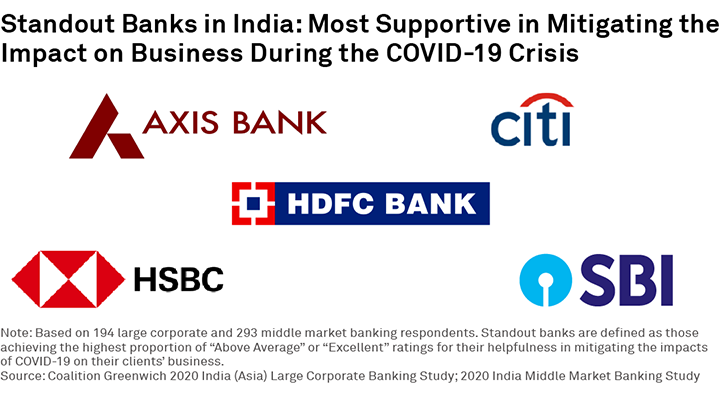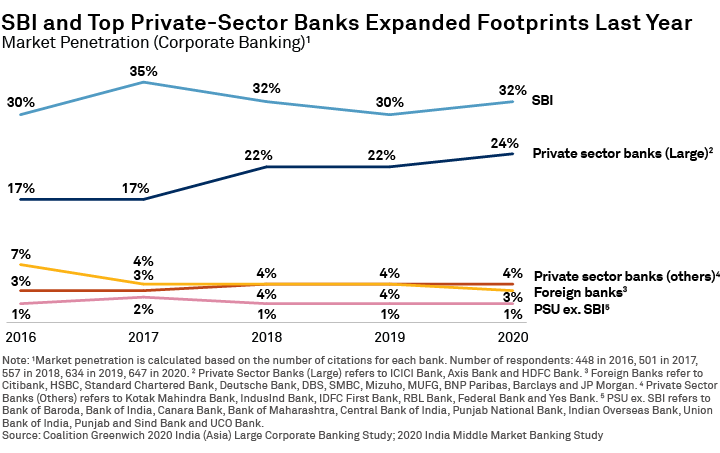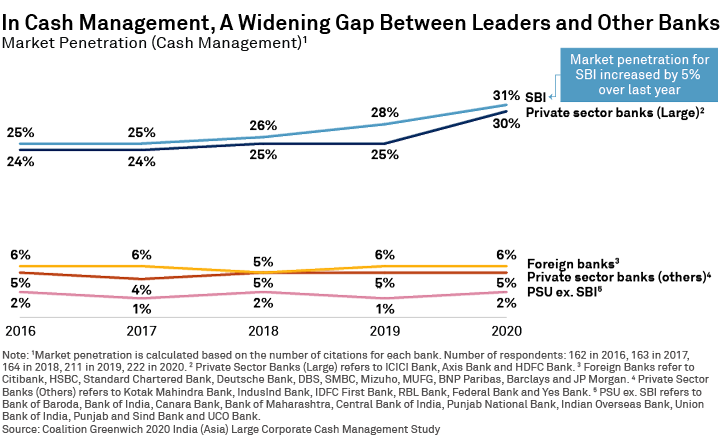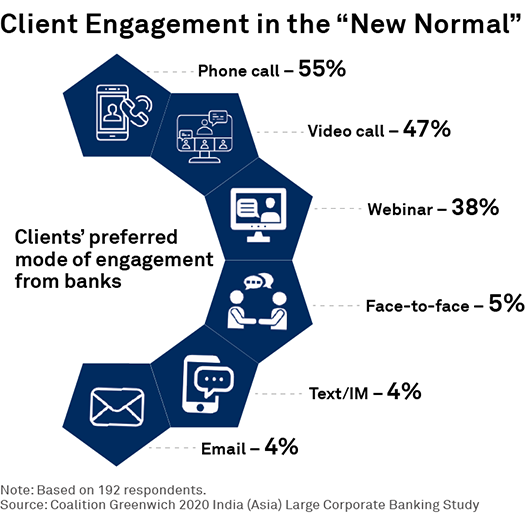Table of Contents

The pressures of COVID-19 could be accelerating the consolidation of the Indian corporate banking industry, as the market’s biggest banks prove themselves best positioned to help large and middle market companies overcome crisis disruptions.
Even before the start of the global pandemic, India’s corporate banking market was on a consolidation path, driven by regulators’ decisive steps to solidify the country’s banking sector and the rapid evolution and growth of the country’s leading private banks. When the pandemic sent the country into lockdown last year, companies needed immediate assistance from banks, at first to ensure financial stability and then to keep businesses running at a time when the economy was at a standstill and employees were stuck at home. For many companies, it was the largest banks that stepped in to help.
The large and middle market companies participating in the Coalition Greenwich 2021 research study rank State Bank of India (SBI) as having done the best job at helping to mitigate the impact of the pandemic. SBI was cited, along with leading private-sector banks, Axis and HDFC, and foreign banks, Citi and HSBC, as companies’ top sources of support during the crisis. The fact that India’s biggest banks were able to quickly marshal the financial, operational and technological capabilities required to provide that assistance is strengthening their relationships with Indian companies and widening the divide between themselves and their competitors.

In this report, we analyze how these important trends are affecting the competitive positioning of corporate banks in India, and present the full list of 2021 Greenwich Share and Quality Leaders, as well as Greenwich Excellence Awards winners in Indian Corporate Banking.
Multiple Trends Pushing Toward Consolidation
In the years leading up to the COVID-19 crisis, the trio of ICICI, Axis and HDFC steadily increased market penetration levels. In 2016, 17% of large and middle market Indian companies were using at least one of these providers as a corporate bank. In 2020, that share climbed to nearly a quarter, with these large private banks growing at a rate of close to 12%–13% year-over-year.
Throughout most of that period, SBI mainly defended its own market-leading penetration levels. In 2020, however, SBI expanded its footprint. Now, nearly a third of Indian corporates cite SBI as one of their top 7-10 corporate banks, and 30% name SBI as a cash management provider.

Corporate relationships captured by the leading private banks and SBI have come from two main sources. First, the “mega merger” orchestrated by the Indian government to shore up the banking sector allowed SBI to absorb the business of six public-sector banks. That exercise also created opportunities for both SBI and private-sector banks to pick up business from clients of smaller public-sector providers engaged in the disruptive consolidation process. Second, both SBI and private-sector banks have been winning relationships at the expense of foreign banks—especially over the past year.
In August 2020, the Reserve Bank of India (RBI) issued its circular restricting banks on opening and operating current accounts of corporates that have taken advantage of banking system limits and made it mandatory to route all transactions through cash credit (CC)/overdraft (OD) accounts in order to check the diversion of funds and ensure that banking activity is retained with key lenders.
Although those rules were just implemented in December, Indian companies have already started citing the new guidelines as a reason to alter lists of cash management providers, with SBI and the large private-sector banks emerging as clear winners. “We are shifting business from [our existing] bank as needed to abide by the new RBI guidelines,” says one study participant. “[Our bank] will lose share in CMS business due to the recent directive by the Reserve Bank of India, where we must consolidate our CMS facility with only main lenders,” adds another. “The bank will lose share because of the RBI circular,” says a third. “[Banks] need to have a greater lending relationship in order to continue the payments business.”

The new directive has put foreign banks under considerable pressure. Even before the circular, foreign banks were finding it more and more difficult to compete with India’s domestic private-sector banks, which are rapidly upgrading capabilities. In addition, their employees are increasingly able to go toe-to-toe with their foreign counterparts, due in large part to the training and experience they received working for foreign banks earlier in their careers.
Now, the RBI circular is further squeezing foreign providers that are being forced to fundamentally reassess their business propositions, narrowing their focus and targeting the clients and businesses in which they have a chance to compete and thrive. There is also a race for “good/strong assets” in order to deploy balance sheet where the bank can get the most return, while maintaining risk quality. While long-established foreign franchises like Citi, Standard Chartered and HSBC are not suffering any major effects due to their sizable balance-sheet commitments to the Indian market, the early impact of this repositioning on other foreign players can be seen in 2020 competitive results, in which foreign banks as a group lost a percentage point of market penetration.
Defining Support: How Banks Helped Companies Survive the Crisis
As these powerful trends were playing out, COVID-19 upended the global economy. Overnight, the pandemic replaced corporate treasury departments’ normal priorities with the more fundamental goal of surviving the crisis. SBI and India’s top private banks were instrumental in helping companies weather the unprecedented disruptions caused by the pandemic.
For both large and middle market companies, the most valuable assistance these banks have provided during the crisis has been operational support, including the ability to maintain smooth transaction processing and deliver timely responses and fast turn-around times on requests. As one study participant recounts, “[Our] bank provided capital market access, improved turnaround time for processing requests and provided necessary support to adopt digital processes, like setting up digital banking access and implementing APIs.” Another Indian corporate adds, “The bank’s digital platform enabled transactions like vendor payments, fund transfers, letters of credit, and bank guarantees.”
Corporates say banks that have helped most also provided critical flexibility in account and loan documentation. That service was particularly prized by large Indian companies, which were much less likely than their middle market counterparts to list financial support or covenant relief as key forms of assistance received from banks during the crisis. After initial disruptions at the start of the pandemic, liquidity remained in relatively easy supply for Indian large corporates throughout much of 2020 and into 2021. As a result, most large companies have not needed to press their banks for excess credit or loan relief.
The situation has been much different for middle market companies, which are more susceptible to economic volatility than their large counterparts and less resilient when it comes to weathering prolonged lockdowns. For these companies, the relaxation of loan terms, conditions and covenants has represented an essential form of support from their banking groups. Middle market companies say their most helpful banks also extended maturity or rescheduled loans, as well as additional credit limits. One study participant explains how his bank helped his company get through the crisis “by giving credit through a COVID emergency loan, in line with the RBI initiative.”
The New Normal: Digital Solutions, Remote Communications
One of the biggest ways banks supported Indian companies in 2020 was by helping them make the abrupt shift to remote work and digital channels in the early days of the COVID-19 crisis. That transition represented an unprecedented challenge for both sides. It will also create some of the most lasting effects of the pandemic on corporate banking relationships. By forcing companies to embrace digital solutions, the crisis has given banks leeway to use technology to generate efficiencies and reduce costs.
Companies cite several innovations that have helped keep them in business during the lockdowns and will continue adding value when COVID-19 subsides. More than half of Indian corporates say they’re benefiting from accelerated transaction processing, which they see as central to the new digital banking experience. Companies are also enthusiastic about innovations in host-to-host integration and API processing that make existing processes more efficient and bring new flexibility to their platforms, allowing them much greater freedom to access and integrate new services and service providers.
But the COVID-era technology likely to have the biggest long-term impact is without a doubt remote communications. After more than a year of lockdowns, virtual engagement (phone/video calls) has really become the norm—technologies that most finance professionals/bankers were using only sparingly or, in many cases, not at all before the pandemic. As one study participant explains, “We would prefer to do regular updates or sharing via webinars or video calls, but any urgent discussion over the phone.” Another Indian corporate agrees, concluding that, “In the new normal, we can contact each other through video and phone calls. To me, they achieve the same effect as in-person meetings…”

Greenwich Share and Quality Leaders Greenwich Excellence Awards
In the large corporate banking segment, the 2021 Greenwich Share Leaders among domestic providers are SBI, HDFC and ICICI, and the 2021 Greenwich Quality Leader is Axis. Among foreign banks competing in India, the 2021 Greenwich Share Leaders are Citi, Standard Chartered and HSBC, with J.P. Morgan claiming the title of 2021 Quality Leader.
In the middle market space, the 2021 Greenwich Share Leaders among domestic providers are HDFC, SBI and ICICI, and the 2021 Quality Leaders are Axis and HDFC. Among foreign banks competing in the middle market segment, the 2021 Greenwich Share Leaders are Standard Chartered, Citi and HSBC, and the 2021 Quality Leaders are HSBC, Standard Chartered and Citi.
The accompanying tables present the complete list of 2021 Greenwich Leaders in Indian Corporate Banking, followed by the Greenwich Excellence Awards winners in Indian Corporate Banking.




Coalition Greenwich Head of Asia, Gaurav Arora, consultant Winston Jin, Wesley Han, Mili Panchmatia, and Pushpak Vanjari specialize in Asian corporate/transaction banking and treasury services.
MethodologyFrom September 2020 to March 2021, Coalition Greenwich conducted interviews with 198 large corporates and 449 middle market businesses in India and asked them to name the banks they use for a variety of services, including corporate lending, cash management, trade services and finance, foreign exchange, structured finance, interest-rate derivatives, and investment banking.
The Greenwich Quality Index (“GQI”) comprises metrics which measure Institutional Relationship Quality and Overall Coverage (i.e., “People”) Quality. Institutional Relationship Quality factors include “Effective Senior Management Support,” “Ease of Doing Business,” “Willingness to Lend,” “Most Competitive Pricing,” and “Ability to Communicate Upfront on KYC Requirements.” Coverage Quality factors include “RM’s Proactive Provision of Advice,” “Knowledge of Transaction Banking Needs,” “Knowledge of International Needs,” “Frequency of Visits,” “Timely Follow Up on Requests,” and “Effective Coordination of Product Specialists.” Study participants were then asked to rate their banks in 14 product and service categories. From September to November of 2019, Greenwich Associates conducted 184 interviews in large corporate banking with companies in India. Subjects covered included product demand, quality of coverage and capabilities in specific product areas.

